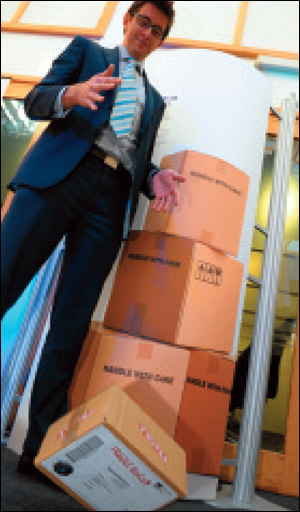With so many consumers shopping online, it’s inevitable that some items will be dropped in transit and broken. Often, the purchaser is unaware until he or she has signed for the package, taken it inside and unwrapped it. Tom Lawrie-Fussey, business development manager at Cambridge Consultants, a product development engineering and technology consulting company, says his firm has come up with a solution. It’s called DropTag, and it’s designed to let a consumer know if a package has been dropped.
The idea started with the development of a Bluetooth device that would allow cars to talk to one another. But when Lawrie-Fussey was trying to determine how to demonstrate the prototype for customers during an “innovation day,” he realized how difficult that would be within the constraints of an office. So he began devising other uses for the technology.
“I came up with the idea of tracking parcels, because many people have had the experience of receiving damaged goods, and it was easy to demonstrate,” he says. “We put the electronics in the box, wrapped it up and showed how our device could tell you the box had been dropped.”
The DropTag consists of an accelerometer (similar to that in a smartphone), which can tell if a package has been dropped, a Bluetooth chip that can run algorithms on data from the accelerometer, a small printed circuit board and a small battery. Lawrie-Fussey says that in volumes of 1 million, the bill of materials for the device would be just $2.50. And the accelerometer could be swapped for a temperature, pressure or humidity sensor.
The DropTag currently has no ID. The device would simply communicate with the consumer’s Bluetooth-enabled mobile phone to indicate whether the packaged item had been dropped. But an ID could be added, along with proper security, so, for instance, a logistics company could use it to identify and track items as well as to monitor their condition. The ID would essentially transform the DropTag into a Bluetooth RFID tag, similar to a Wi-Fi tag.
Lawrie-Fussey says the device could also be developed with Near-Field Communication technology instead of Bluetooth. “With NFC phones proliferating, I could easily see consumers accessing the data in a DropTag via NFC,” he says. “We chose Bluetooth because of the longer read range. With Bluetooth, a driver could easily determine whether any of the packages in the back of the truck had been dropped.”
Cambridge Consultants is in discussions with several logistics companies interested in commercializing the DropTag. It’s also talking with firms that offer more expensive parcel-monitoring devices. So it might not be long before you know whether that flat-screen TV has been tossed around in the back of a truck or treated with kid gloves.


